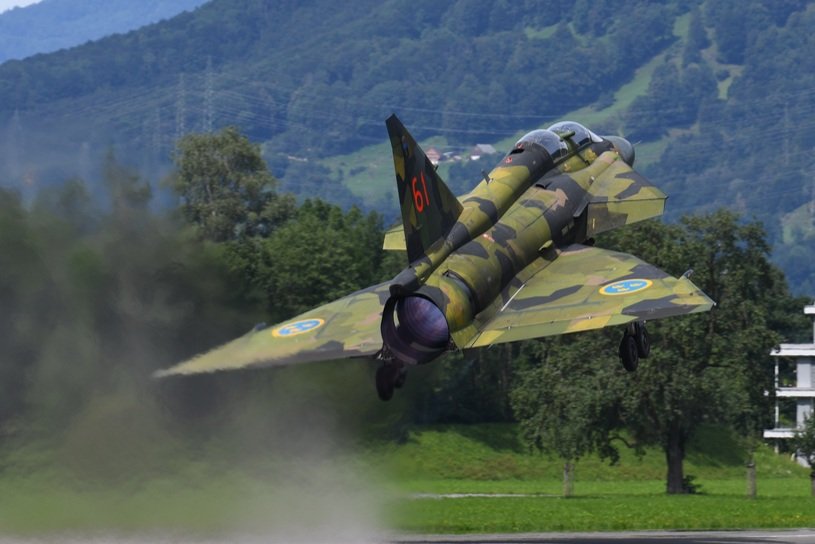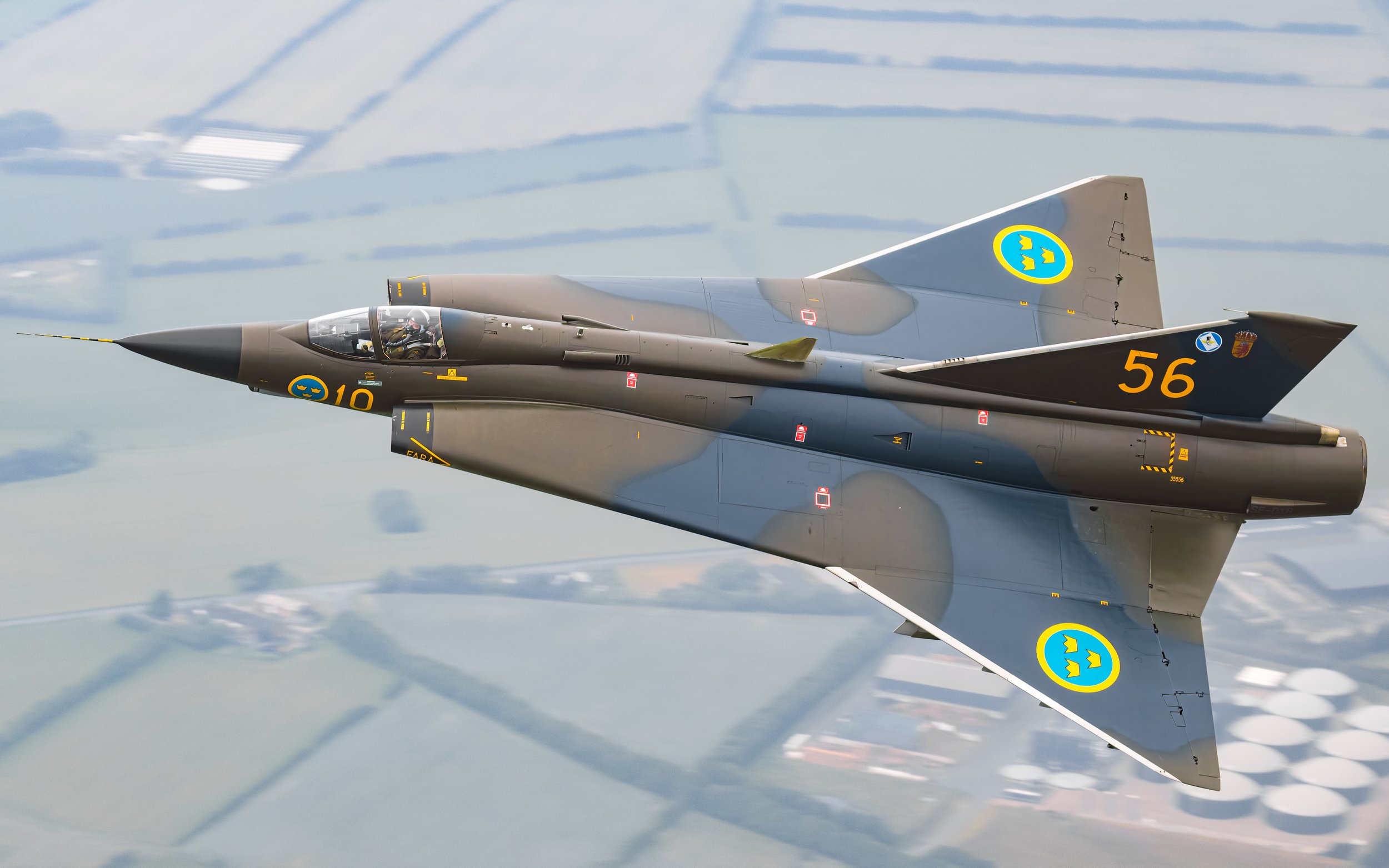DC-3 SE-CFP
Year built
1943
Aircraft
C-47A-60-DL
Base
Stockholm Bromma Airport
Daisy was manufactured at Douglas Aircraft Company's plant in Long Beach, California with the construction number13883, as a C-47 A-60-DL Skytrain, a military version of the DC-3 with a large cargo door, reinforced floor and larger fuel tanks.
She was delivered to the United States Army Air Force on October 5, 1943, and received USAAF serial number 43-30732. The numbers 330732 were painted on the tail fin.
Daisy was manufactured in the middle of World War II and delivered directly to the US Army Air Forces in October 1943 and was based in Oran, Algeria. There she transported troops, goods and supplies. In 1944, she was relocated to England in preparation for the Allied invasion of German-occupied Europe and took part in Day D on June 6, 1944.
At the end of the war, Daisy returned to the United States on September 23, 1945, and was transferred to the Reconstruction Finance Corporation (RFC), a U.S. government agency that sold military surplus supplies. In 1946, she was converted from a military C-47 to a civilian DC-3C by Canada Air Ltd. The conversion included replacing the large cargo doors with a standard passenger door and soundproofing the cabin and providing more comfortable seats.
Daisy was sold after the conversion to Det Norske Luftfartselskap (DNL). In Norway, she received the civil registration number LN-IAF and the name Nordfugl. In 1948, DNL, Det Danske Luftfartselskab (DDL) and Swedish AB Aerotransport (ABA) formed the joint Nordic airline Scandinavian Airlines System, (SAS). Nordfugl was now repainted in SAS 'classic "dragon painting" and the name Fridtjof Viking. Daisy thus became one of SAS's first aircraft.
In 1957, Daisy was sold to ABA for use in Linjeflyg and received Swedish registration SE-CFP on 13 August the same year, after which she was put into Linjeflyg's traffic. In 1960, the company suffered financial difficulties and therefore sold two of its DC-3s, SE-CFP and her sister SE-CFR to the Swedish Air Force.
In the Air Force, DC-3 had the type designation Tp 79. Daisy's air force number was 79006. After first regaining military cargo doors at the Swedish Airports Workshops at Bulltofta, she was first based on F 7 Såtenäs and then on F 3 Malmslätt, which then became a detachment to F 13 in Norrköping. During her time in the Air Force, she was hired out to the Red Cross for humanitarian efforts in Ethiopia. During three months there, she transported 325 tons of supplies and 826 passengers!
Between 1982 and 1984, the Swedish Air Force phased out its last Tp 79s. 79006 was sold in 1982 to two private individuals, Ingemar Wärme and Jimmie Berglund for SEK 80,000. These two founded a foundation, Flying Veterans and sold the plane to the foundation in 1983. They also formed the association Flying Veterans the same year, for the plane's technical and financial management. In the meantime, the foundation's founders, together with voluntary forces, had carried out a comprehensive technical review and restoration of the aircraft to its civilian condition. On June 26, 1984, she regained the same civilian registration she had during her time in Linjeflyg, SE-CFP.
She is christened Daisy and the premiere tour as a privately owned veteran aircraft takes place in June 1984.
In connection with SAS's 40th anniversary in 1986, the plane regained the kite decoration she wore during her time at SAS 1948-1957 with the name Fridtjof Viking painted on her nose. This was originally intended to be a temporary painting, but after SAS then decided to remain as the association's sponsor, the aircraft has been allowed to retain its appearance. This even after SAS ceased its sponsorship.
| Back to Top |
Douglas DC-3
The Douglas DC-3 was a revolutionary propeller-driven airliner that significantly impacted the airline industry during the 1930s and 1940s, as well as during World War II. It was developed by the Douglas Aircraft Company as an improved version of the Douglas DC-2, with a larger and more comfortable 14-bed sleeper, which helped to set a new standard in air travel.
The aircraft is a low-wing metal monoplane with conventional landing gear, powered by two radial piston engines that produce 1,000-1,200 hp (750-890 kW). Although most DC-3s that are still flying today use Pratt & Whitney R-1830 Twin Wasp engines, many of the planes originally built for civil service were equipped with the Wright R-1820 Cyclone engine. This engine was less powerful than the Twin Wasp, but it was more economical and reliable.
The DC-3 was a notable improvement in many ways compared to previous aircraft. It was faster, more reliable, and had a longer range, providing passengers with greater comfort. Prior to the war, it pioneered many air travel routes and was capable of crossing the continental US from New York to Los Angeles in just 18 hours with only three stops. Additionally, it was one of the first airliners to efficiently carry only passengers without relying on mail subsidies.
During the war, the DC-3 played a vital role as a military transport aircraft. It was used extensively by the United States Army Air Forces (USAAF) and the Royal Air Force (RAF) for a wide range of missions, including paratroop drops, aerial resupply, and medical evacuation. Military versions of the DC-3, including the C-47 Skytrain (known as the Dakota in British RAF service), as well as Soviet- and Japanese-built versions, brought total production to over 16,000.
Following the war, the market was flooded with surplus transport aircraft, and the DC-3 was no longer competitive due to its size and speed. It was replaced on main routes by more advanced types, such as the Douglas DC-4 and Lockheed Constellation, but the design proved to be adaptable and useful on less glamorous routes. Many DC-3s were converted into cargo planes, and some were modified for use as executive transports and aerial survey platforms.
Civil DC-3 production was discontinued in 1942, with a total of 607 aircraft produced. However, the DC-3 continued to serve in a variety of roles in many countries around the world. Even today, many DC-3s continue to fly in a variety of niche roles, with an estimated 2,000 still in operation in 2013 and over 300 still in service as of 2017. The aircraft's durability, versatility, and reliability make it a popular choice for operators who require a dependable workhorse that can operate from short runways in remote locations.
| Back to Top |


| Back to Top |














